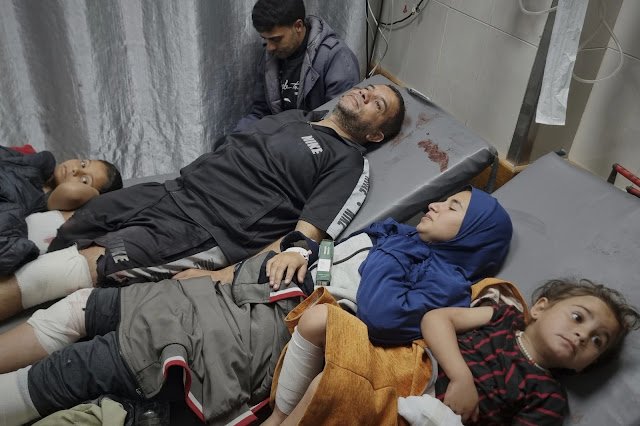Israel launched airstrikes across the Gaza Strip early Tuesday that killed more than 400 Palestinians, local health officials said, shattering a ceasefire in place since January as it vowed to force Hamas to release more hostages and relinquish control of the territory.
Prime Minister Benjamin Netanyahu ordered the strikes after Hamas refused Israeli demands to free half of the remaining hostages as a precondition for extending the ceasefire. Israel’s deadliest bombardment of the territory in the 17-month war killed mostly women and children, according to the Gaza Health Ministry.
Netanyahu said the attack was “only the beginning” and that Israel would press ahead until it achieves all of its war aims — destroying Hamas and freeing all hostages held by the militant group.
Hamas said at least six senior officials were killed in Tuesday’s strikes. Israel said they included the head of Hamas’ civilian government, a justice ministry official and two security agency chiefs.
All further ceasefire negotiations will take place “under fire,” he said in a statement aired on national television. The White House said it had been consulted and voiced support for Israel’s actions.
“In every room I found the dead. ... I finish in one place and go to another, and I find more dead,” he said. “I don’t know if we’re in a state of war or truce.”
The attack could signal the full resumption of a war that has already killed tens of thousands of Palestinians and caused widespread destruction across Gaza. It also raised concerns about the fate of the roughly two dozen hostages held by Hamas who are believed to still be alive.
A senior Hamas official said Netanyahu’s decision to return to war amounts to a “death sentence” for the remaining hostages. Izzat al-Risheq accused Netanyahu of launching the strikes to save his far-right governing coalition. There were no reports of any attacks by Hamas several hours after the bombardment.
But Yemen’s Houthi rebels fired rockets toward Israel for the first time since the ceasefire began. The volley set off sirens in Israel’s southern Negev desert but was intercepted before it reached the country’s territory, the military said. The U.S. over the weekend launched deadly strikes against the Iranian-backed Houthis.
Israel’s return to a military campaign came as Netanyahu faces mounting domestic pressure, with mass protests planned over his handling of the hostage crisis and his decision to fire the head of Israel’s internal security agency. His latest testimony in a long-running corruption trial was canceled after the strikes.
The strikes appeared to give Netanyahu a political boost. A far-right party led by Itamar Ben-Gvir that had bolted the government over the ceasefire announced Tuesday it was rejoining.
The main group representing families of the hostages accused the government of “deliberately dismantling” the ceasefire. Thousands of Israelis packed a Tel Aviv square Tuesday evening to protest Netanyahu’s intention to fire the country’s domestic security chief and demand the government to resume negotiations for a hostage deal.
“Today Netanyahu did not open the gates of hell on Hamas. He opened the gates of hell on our loved ones,” said Einav Zangauker, whose son is among the hostages.
Wounded stream into Gaza hospitals
After two months of relative calm during the ceasefire, stunned Palestinians found themselves once again digging loved ones out of rubble and holding funeral prayers over the dead at hospital morgues.
“Nobody wants to fight,” Nidal Alzaanin, a resident of Gaza City, said. “Everyone is still suffering from the previous months.”
A hit on a home in Rafah killed 17 members of one family, according to the European Hospital, which received the bodies. The dead included five children, their parents, and another father and his three children. Another in Gaza City killed 27 members of a family, half of them women and children, including a 1-year-old, according to a list of the dead put out by Palestinian medics.
By noon on Tuesday, Nasser Hospital had received the bodies of at least 28 children killed in recent violence, according to records shared by Ahmed Al-Farra, head of pediatrics and obstetrics.
At Khan Younis’s Nasser Hospital, patients lay on the floor, some screaming. A young girl cried as her bloody arm was bandaged. Wounded children overwhelmed the pediatric ward, said Dr Tanya Haj-Hassan, a volunteer with Medical Aid for Palestinians aid group.
She said she helped treat a 6-year-old girl with internal bleeding. When they pulled away her curly hair, they realized shrapnel had also penetrated the left side of her brain, leaving her paralyzed on the right side. She was brought in with no ID, and “we don’t know if her family survived,” Haj-Hassan said.
Gaza’s Health Ministry said the strikes killed at least 404 people and wounded more than 560. Zaher al-Waheidi, head of the ministry’s records department, said at least 263 of those killed were women or children under 18. He described it as the deadliest day in Gaza since the start of the war.
In his statement Tuesday, Netanyahu blamed Hamas for civilian casualties, saying it operates among the population.
















0 Comments